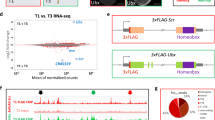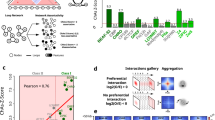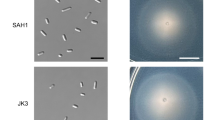Abstract
IN Drosophila, the adult structures arise from nests of larval cells called imaginal disks, whose state of determination with respect to disk type is usually fixed. However, two processes are known which can change determination from one disk type to another; one occurs in situ and is due to homeotic mutations, and the other is seen after culture of disk material and is called transdetermination. Similarities between the two, notably the lack of intermediate states, have led to the idea that they are different aspects of the same phenomenon1,2. The existence of homeotic mutations argues that determination in normal development is underlain by a genetic switching mechanism3,4; transdetermination could result from epigenetic changes in this system. If this is so then the two phenomena should have characteristics in common. Studies of homeotic mutants have shown that a structure in one disk is always transformed into a specific structure from the other disk5,6; for example clones of bithorax in an anterior dorsal position in the haltere show anterior dorsal wing structures5. This is used as a criterion of homology, and also indicates that all disks use the same positional information7. Differences between disks must be due to different interpretation of this information, mediated in some way by the wild-type alleles of the homeotic genes. It is not yet known whether transdetermination also shows position-specific transformation; if the two phenomena are closely related then this should be the case. It is often assumed to be so, because there have been reports of transdetermination between leg and antenna in which structures such as claw and arista, thought from homeotic mutants to be homologous, are found adjacent to one another in implants1. However, these findings could also be explained by non-homologous transdetermination followed by either movement together of homologous structures due to preferential cell affinities, or intercalary regeneration between the non-homologous structures. Also, regeneration before transdetermination can give misleading results. One cannot simply ask to what structures a given disk fragment will transdetermine as the fragment might regenerate the rest of the disk first, and non-regenerating (that is duplicating) fragments do not appear to transdetermine (unpublished observations, and ref. 8). One solution to these problems is to find a disk in which transdetermination occurs only in one part, and this is the case in the foreleg disk. The experiments reported here were designed to find whether this part transdetermines to a homologous part of the wing disk.
This is a preview of subscription content, access via your institution
Access options
Subscribe to this journal
Receive 51 print issues and online access
$199.00 per year
only $3.90 per issue
Buy this article
- Purchase on SpringerLink
- Instant access to full article PDF
Prices may be subject to local taxes which are calculated during checkout
Similar content being viewed by others
References
Postlethwait, J. & Schneiderman, H. A. Rev. Genet. 7, 381–433 (1974).
Gehring, W. in The Biology of Imaginal Discs (eds Ursprung, H. & Nöthiger, R.) 1–34 (Springer, Berlin, 1972).
Garcia-Bellido, A. Ciba Fndn Symp. 29, 161–182 (1975).
Kauffman, S. Science 181, 310–318 (1973).
Morata, G. & Garcia-Bellido, A. Wilhelm Roux' Arch. 179, 125–143 (1976).
Postlethwait, J. & Schneiderman, H. Devl Biol. 25, 606–640 (1971).
Wolpert, L. J. theor. Biol. 25, 1–47 (1969).
Schubiger, G. Devl Biol. 26, 277–295 (1971).
Strub, S. Wilhelm Roux' Arch. 182, 69–74 (1977).
Lindsley, D. & Grell, E. G. Genetic Variations of Drosophila melanogaster, 552 (Carnegie Institution of Washington Publications, 627 1968).
Hadorn, E. Devl Biol. 13, 424–509 (1966).
Strub, S. Wilhelm Roux' Arch. 182, 75–92 (1977).
Wilcox, M. & Smith, R. J. Devl Biol. 60, 287–297 (1977).
Bryant, P. J. J. exp. Zool. 193, 49–78 (1975).
Garcia-Bellido, A. Am. Zool. 17, 613–629 (1977).
Gehring, W. Devl Biol. 16, 438–456 (1967).
Garcia-Bellido, A. Expl Cell Res. 44, 383–392 (1966).
Author information
Authors and Affiliations
Rights and permissions
About this article
Cite this article
KARLSSON, J. A major difference between transdetermination and homeosis. Nature 279, 426–428 (1979). https://doi.org/10.1038/279426a0
Received:
Accepted:
Published:
Issue date:
DOI: https://doi.org/10.1038/279426a0
This article is cited by
-
Cell fate changes induced by a Distal-less enhancer-trap transgene in the Drosophila antennal imaginal disc
Scientific Reports (2018)
-
Homologies of positional information in thoracic imaginal discs ofDrosophila melanogaster
Wilhelm Roux's Archives of Developmental Biology (1982)
-
Transdetermination in leg imaginal discs ofDrosophila melanogaster undDrosophila nigromelanica
Wilhelm Roux's Archives of Developmental Biology (1981)



